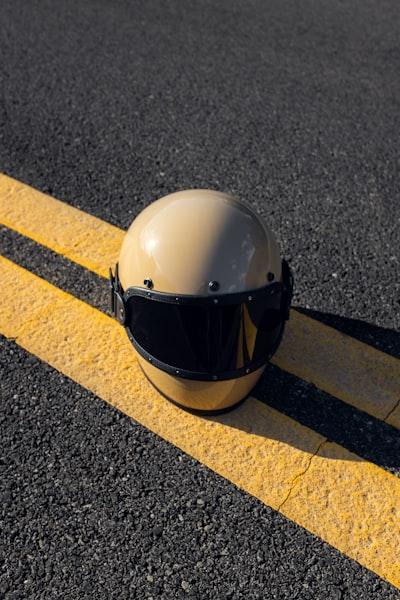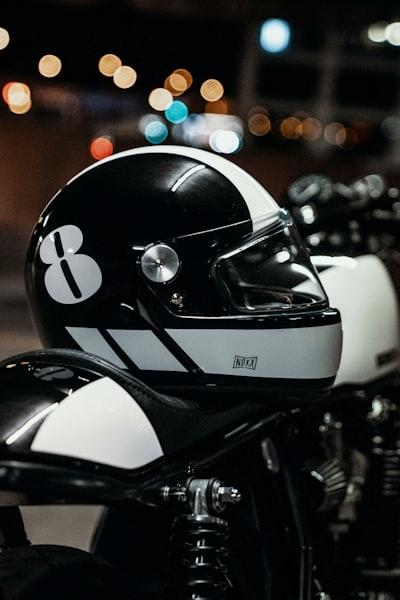Introduction
Have you ever noticed a helmet resting casually behind a motorcycle and wondered if there’s more to this image than meets the eye? What does a helmet behind a motorcycle mean? This seemingly mundane detail can carry a weight of intrigue and symbolism. Helmets are not just for safety; their placement can also speak volumes, offering a glimpse into a deeper narrative entwined with cultural significance and personal expression.
What Does a Helmet Behind a Motorcycle Mean?
At first glance, a helmet behind a motorcycle might seem purely functional, but there’s an air of mystery that surrounds it. Why is it placed there and not secured on the rider’s head or locked away? Could it be an invitation to a would-be passenger, a sign of a brief respite, or perhaps a silent nod to a fellow biker? These questions open up a world of speculation and curiosity, setting the stage for a fascinating exploration into the language of symbols that permeate our everyday lives.
Table of Contents
- Introduction
- What Does a Helmet Behind a Motorcycle Mean?
- What Does a Helmet Behind a Motorcycle Mean: Highlighting the Importance of Symbols and Their Hidden Meanings in Different Contexts
- What Does a Helmet Behind a Motorcycle Mean: Previewing How Understanding This Symbolism Can Enhance Our Perception of Motorcycles
- Decoding the Symbolism
- Analyzing the Historical Context of Helmets and Motorcycles
- Discussing Common Interpretations of a Helmet Placed Behind a Motorcycle
- Exploring Cultural and Regional Variations in the Symbolism Associated with This Placement
- Significance and Safety
- Connecting Symbolic Meaning to Safety Practices
- Helmet Placement and Rider Awareness
- Symbolic Significance Versus Practical Behavior
- Interpreting Intentions: What Does a Helmet Behind a Motorcycle Mean?
- The Psychology Behind Symbolism
- Personal Beliefs and Interpretation
- The Dual Role of the Helmet
- What Does a Helmet Behind a Motorcycle Mean: Conclusion and Call-to-Action
- What Does a Helmet Behind a Motorcycle Mean: Reflecting on Everyday Symbols
- What Does a Helmet Behind a Motorcycle Mean: Deepening Symbolic Literacy
What Does a Helmet Behind a Motorcycle Mean: Highlighting the Importance of Symbols and Their Hidden Meanings in Different Contexts
Symbols are powerful tools for communication, transcending spoken language and cultural barriers. They can convey complex ideas, emotions, and identities. In various contexts, a single symbol can be imbued with multiple meanings, shaped by historical events, social norms, and individual experiences. By acknowledging the importance of symbols, we begin to unravel the layers of meaning that lie beneath common objects and gestures, enriching our understanding of the world and the people within it.
What Does a Helmet Behind a Motorcycle Mean: Previewing How Understanding This Symbolism Can Enhance Our Perception of Motorcycles
Motorcycles themselves are emblematic, often associated with freedom, adventure, and rebellion. When we start to decode the symbolism of a helmet‘s placement, we can deepen our appreciation for the motorcycle as more than just a mode of transportation; it becomes a canvas for self-expression. This insight allows us to perceive motorcycles not solely in terms of their utility but as part of a broader narrative that encompasses the values, stories, and aspirations of those who ride them.

Decoding the Symbolism
The allure of the open road and the rumble of a motorcycle engine have long captivated the human spirit. But to truly understand the culture of motorcycling, one must delve into the layers of meaning behind every element, including the seemingly simple act of placing a helmet behind the bike. Let’s peel back these layers together.
Analyzing the Historical Context of Helmets and Motorcycles
Since their inception, motorcycles have symbolized freedom, adventure, and rebellion. These two-wheeled machines were not just transportation; they became icons of an entire lifestyle. The helmet, initially designed for protection, has evolved alongside motorcycles, adopting its own set of meanings. From early leather caps to modern aerodynamic designs, helmets reflect the progression of safety and technology in motorcycling history. Today, they are as much a fashion statement as they are lifesaving equipment.
Discussing Common Interpretations of a Helmet Placed Behind a Motorcycle
A helmet resting on the rear of a motorcycle can be a puzzling sight. To some, it may signal the presence of a passenger, hinting at stories of shared adventures and companionship on the road. For others, it could represent readiness, suggesting the rider is prepared to embark on a journey at a moment’s notice. This placement could also be seen as a mark of respect, with the helmet serving as a tribute to the machine it accompanies. These interpretations vary widely, but each adds depth to the relationship between rider, machine, and the road they travel.
Exploring Cultural and Regional Variations in the Symbolism Associated with This Placement
Cultural and regional differences can significantly influence the interpretation of symbols. In some parts of the world, a helmet placed behind a motorcycle might be a practical choice, keeping it safe from theft or damage. In other locales, such placement could have specific social implications, perhaps signaling a rider’s status within a group. It’s fascinating to consider how diverse cultures add their unique spin to this common practice, embedding local values and norms into a global symbol of motorcycling culture.

Significance and Safety
The interplay between symbolism and safety is not always apparent, yet it holds profound significance in the context of motorcycle culture. When a helmet is placed behind a motorcycle, it not only serves as a symbol but also carries a critical message about the rider’s commitment to safety. This placement can be a subtle reminder that, despite the freedom associated with riding, safety should never take a back seat.
Connecting Symbolic Meaning to Safety Practices
At first glance, the sight of a helmet resting behind a motorcycle could be seen as a mere aesthetic or convenience choice. However, this action transcends mere functionality. The helmet, a universally recognized emblem of safety, silently communicates the importance of protective gear. A rider who chooses to display their helmet prominently rather than tucking it away conveys a message of responsibility and an acknowledgment of the risks involved in motorcycling. This gesture reinforces the notion that safety is integral to the riding experience and should always be a priority.
Helmet Placement and Rider Awareness
The relationship between where a helmet is placed and rider awareness might seem tenuous, but there is an intrinsic connection. Placing a helmet behind a motorcycle can serve as a visual cue, sparking an internal dialog about safety before a rider even sets off. It acts as a last-minute check—ensuring that the rider has not forgotten their crucial headgear. Additionally, for onlookers, it can highlight the importance of wearing a helmet, potentially influencing public attitudes towards safety in the broader context of motorcycling.
Symbolic Significance Versus Practical Behavior
This brings us to a pivotal question: Should the symbolic significance of a helmet influence actual behavior regarding its use? Some may argue that symbols are powerful motivators and that reinforcing positive symbolism can lead to better safety practices. Others might claim that practical considerations should stand apart from symbolic interpretations. Nonetheless, what remains clear is that the helmet’s representation of protection is more than a mere symbol—it is a tangible lifesaver. As such, its presence, whether as a symbol or a practical tool, should encourage its consistent use.

Interpreting Intentions: What Does a Helmet Behind a Motorcycle Mean?
Why do we place symbols in our lives, and what messages are they quietly conveying? In the context of motorcycle culture, a helmet isn’t just about protection—it’s a canvas for personal expression and communal values. Let’s delve into the psychology behind using symbols to convey messages.
The Psychology Behind Symbolism
Symbols hold power because they communicate beyond words, tapping into shared experiences and emotions. A helmet positioned behind a motorcycle might be seen as a representation of the rider’s identity or as an emblem of the broader biking community. Psychologists suggest that humans have an innate tendency to find meaning in objects, a concept known as pareidolia. This predisposition allows us to attach significance to symbols, such as a helmet, which then become infused with personal and cultural meaning.
Personal Beliefs and Interpretation
Each person’s background can dramatically color their interpretation of symbols. For instance, a veteran biker might see the helmet as a badge of honor, symbolizing years of experience on the road. Conversely, someone who has lost a loved one in a motorcycle accident might view the helmet as a poignant reminder of life’s fragility. The same object, viewed through different lenses of personal beliefs and values, can take on contrasting narratives.
The Dual Role of the Helmet
On one hand, a helmet is unquestionably a safety device, a critical piece of gear designed to protect. On the other, it serves as a symbolic object laden with potential meanings: freedom, caution, belonging, or adventure. The duality of the helmet’s role illustrates the complex relationship we have with everyday objects and how they can serve multiple purposes in our lives.
What Does a Helmet Behind a Motorcycle Mean: Conclusion and Call-to-Action
As we’ve journeyed through the subtle yet profound world of symbols, specifically the helmet resting behind a motorcycle, we’ve uncovered layers of meaning that transcend its immediate function. This exploration has revealed that symbols, like the helmet, are not just objects but vessels of communication, imbued with the culture and personal experiences of those who interpret them.
Motorcycle culture itself is rich with symbolism, where every accessory and custom carries a meaning, from freedom and rebellion to camaraderie and respect. The helmet, while primarily a safety apparatus, is also a canvas on which riders project their identity. It is an emblem of responsibility and an unspoken nod to the inherent risks of the road. To see a helmet behind a motorcycle is to witness a story – one of adventure, caution, or perhaps even loss.
What Does a Helmet Behind a Motorcycle Mean: Reflecting on Everyday Symbols
We are surrounded by symbols that shape our perception of the world. From traffic signs to company logos, these everyday icons silently guide our actions and influence our thoughts. By understanding the symbolism in objects around us, like the helmet behind a motorcycle, we become more attuned to the nonverbal dialogues that permeate our environment. The call here is simple yet profound: pause and reflect. What hidden messages are you walking past every day? How do they inform your understanding of the world and your place within it?
What Does a Helmet Behind a Motorcycle Mean: Deepening Symbolic Literacy
Recognizing the importance of symbols is merely the first step. To truly grasp the depth of communication they offer, we must engage in further research and practice. For those intrigued by the silent language of symbolism, diving into semiotics—the study of signs and symbols and their use or interpretation—can be enlightening. Whether through academic study, reading about cultural history, or simply observing and questioning the world around you, enhancing your symbolic literacy can enrich your interactions and broaden your perspective.
Moreover, as responsible members of a shared space, we have the power to influence the dialog. By choosing what symbols we display and how we interact with them, we contribute to the collective narrative. Whether a motorcyclist or not, consider what symbols you carry into the public eye and what messages they may convey to others. Your choices are part of a larger conversation, one that can promote safety, awareness, and mutual understanding.

